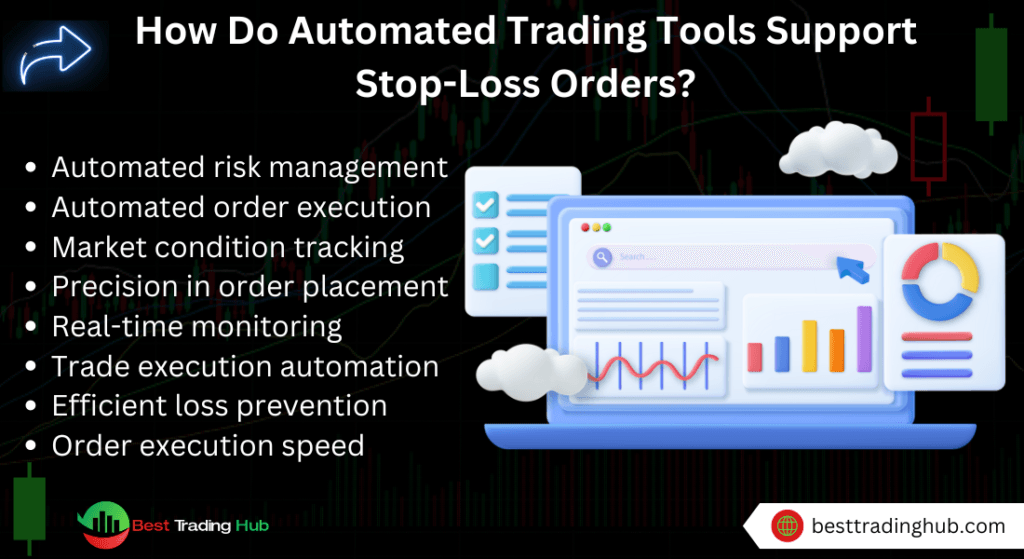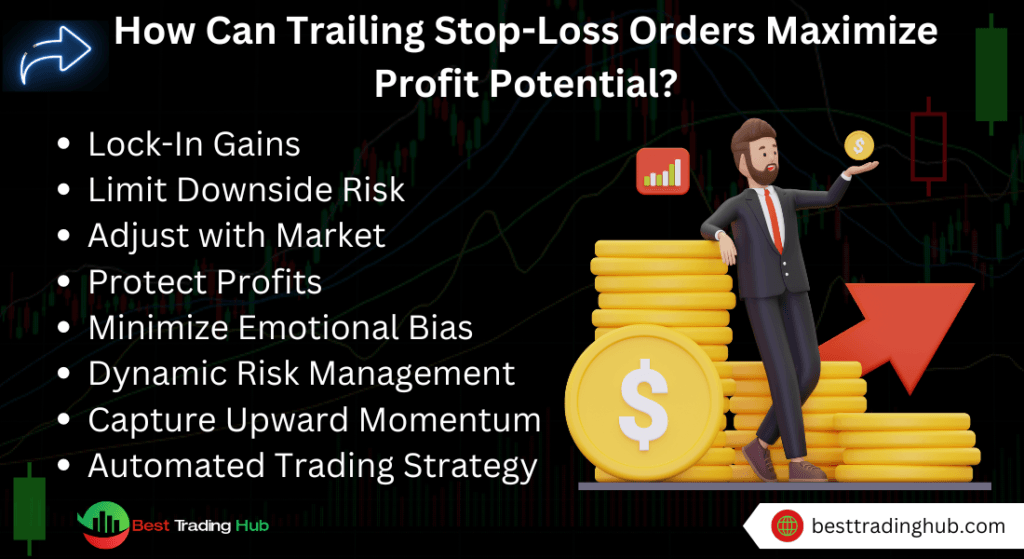In the volatile world of trading, minimizing losses is just as important as maximizing gains. Using Stop-Loss Orders is a strategic approach that helps traders protect their investments by automatically selling off assets when they hit a predetermined price. This tool can be a lifesaver, especially in markets prone to sudden fluctuations. Whether you’re new to trading or an experienced investor, understanding how and when to implement stop-loss orders is essential for effective risk management.
Stop-loss orders not only provide a safeguard against significant losses but also remove the emotional element from trading. By automating the sell-off process, traders can maintain discipline and stick to their trading plans without the fear of second-guessing market movements. Implementing this technique can lead to a more structured, strategic trading process, helping you stay focused on your long-term financial goals.
Table of Contents
What is a Stop-Loss Order, and How Does it Work?
A stop-loss order is a pre-defined order that instructs a broker to sell a security once it reaches a specific price. The goal of a stop-loss order is to limit an investor’s loss on a position, providing an automatic exit from a trade if the market moves against them. This type of order is particularly useful for volatile markets, where prices can change rapidly.
When a stop-loss order is triggered, the trade is executed at the best available price, depending on market conditions. Traders use stop-loss orders to protect their portfolios from significant losses, particularly in situations where they cannot continuously monitor market movements. Understanding how stop-loss orders work is fundamental for investors who want to automate part of their risk management strategy.
Key Points:
- Automatically triggers a sale at a pre-set price.
- Helps limit losses without constant market monitoring.
- Effective in volatile markets to prevent major setbacks.
Why Should Traders Use Stop-Loss Orders?
Using stop-loss orders offers several benefits to both novice and seasoned traders, primarily as a safeguard against unexpected market downturns. In highly liquid and volatile markets, price movements can be unpredictable, and having a stop-loss in place can prevent traders from experiencing large, unforeseen losses.
In addition to limiting downside risk, stop-loss orders also help traders maintain discipline. Often, emotional trading leads to poor decisions such as holding onto a losing position in the hope that it will recover. A stop-loss removes this emotion from the equation, ensuring that traders stick to their strategy rather than reacting to market noise.
Benefits of Stop-Loss Orders:
- Protects against excessive losses during market volatility.
- Removes the emotional component from trading decisions.
- Ensures adherence to trading strategies and risk management plans.
How to Set a Stop-Loss Order: Step-by-Step Guide
Setting a stop-loss order requires careful consideration of several factors, including the asset’s price volatility and your risk tolerance. The goal is to place the stop-loss at a price point that provides enough room for normal market fluctuations while preventing excessive losses. Below is a step-by-step guide on how to set a stop-loss order effectively.

- Determine Your Risk Level: Decide how much of your investment you are willing to lose on a single trade. Typically, traders set this level between 1% and 5% of their overall investment per trade.
- Identify Your Entry and Exit Points: Before setting the stop-loss, identify your target profit and loss levels. This ensures that the stop-loss order aligns with your broader trading strategy.
- Place the Order: Use your broker’s trading platform to enter the stop-loss order. Input the specific price at which you want the trade to be executed if the market moves against your position.
Sub-Heading: Key Considerations When Setting Stop-Loss Orders
- Market Volatility: Be cautious of placing your stop-loss too close to the current market price in highly volatile markets, as it could trigger prematurely.
- Position Size: Ensure the size of your trade justifies the stop-loss distance to avoid large losses relative to your overall portfolio.
By following these steps, traders can ensure that their stop-loss orders are not only well-placed but also align with their overall risk management strategy, ensuring long-term success in the market.
What Types of Stop-Loss Orders Are Available?
Stop-loss orders come in various forms, each serving a specific purpose depending on the trader’s objectives and the market environment. Understanding the types of stop-loss orders can help traders select the best option for their strategy.
- Standard Stop-Loss Order: This is the most common form of stop-loss, where an asset is sold at the best available price once the stop price is reached. It is ideal for traders who want to limit losses without specifying a particular price for the sale beyond the stop price.
- Stop-Limit Order: This order is similar to a stop-loss but adds a limit price, meaning the order will only be executed at the stop price or better. It provides more control but carries the risk of the order not being filled if the asset doesn’t hit the limit price.
- Trailing Stop-Loss Order: A trailing stop adjusts automatically as the asset price moves in the trader’s favor. This type of order locks in profits while still providing protection from downside risk. Trailing stops are particularly useful in volatile markets where prices can fluctuate widely.
Types of Stop-Loss Orders Summary:
- Standard Stop-Loss: Triggers a sale at the best price once the stop price is hit.
- Stop-Limit Order: Adds a limit to the price, ensuring the trade is only executed at or above the stop price.
- Trailing Stop-Loss: Adjusts dynamically based on price movements to secure profits while limiting losses.
When is the Best Time to Use a Stop-Loss Order?
The timing of placing a stop-loss order is just as crucial as the type of stop-loss used. Traders should carefully consider market conditions, their risk tolerance, and the nature of the asset being traded.
During High Market Volatility: Stop-loss orders are especially valuable during periods of high market volatility when price swings are more frequent and severe. For traders who cannot monitor the market continuously, using a stop-loss ensures protection from unexpected downturns that can occur outside of trading hours or during sudden market shocks.
When Trading High-Risk Assets: For speculative trades or investments in highly volatile assets, a stop-loss order is essential to avoid significant losses. Cryptocurrencies, for instance, often experience large price swings within short timeframes, making a stop-loss crucial to safeguard capital.
Time-Sensitive Trades: If a trader plans to be away from their trading platform for an extended period, a stop-loss order can be a safeguard against market shifts that occur when they are unavailable to act.
Key Times for Stop-Loss Orders:
- High volatility periods.
- Trading high-risk, speculative assets.
- When unable to monitor the market closely.
How Can a Stop-Loss Order Protect Your Portfolio?
Stop-loss orders serve as an automatic mechanism for portfolio protection, helping to mitigate large losses and ensuring a disciplined approach to risk management. By setting predefined exit points, traders prevent emotional decision-making, which often leads to holding onto losing trades for too long.
Limiting Downside Risk: One of the primary benefits of a stop-loss order is its ability to limit the downside risk on any given trade. By automating the sale of an asset when it reaches a specific price, traders can safeguard their portfolios from experiencing catastrophic losses, especially during times of market instability.
Protecting Gains: In addition to protecting against losses, stop-loss orders—particularly trailing stop-losses—can also lock in profits. As an asset’s price rises, the stop-loss follows it, ensuring that gains are realized without needing to manually monitor the trade.
Reducing Emotional Trading: Traders often face the temptation to hold on to losing positions in hopes of a market reversal. A stop-loss order helps enforce discipline by ensuring the trade is exited at a predetermined point, thereby reducing the chances of significant portfolio damage due to emotional decision-making.
How Stop-Loss Orders Protect:
- Minimize large losses during market downturns.
- Lock in profits using trailing stop-losses.
- Remove emotional bias from trading decisions.
What Are the Risks Associated with Stop-Loss Orders?
While stop-loss orders are invaluable tools for risk management, they come with their own set of risks. Understanding these risks allows traders to make informed decisions about when and how to use stop-losses in their trading strategies.

Slippage Risk: One of the primary risks of stop-loss orders is slippage, which occurs when the order is executed at a different price than the stop-loss price. This typically happens in fast-moving markets where prices can jump past the stop-loss level before the order can be executed. In such cases, traders might sell at a significantly lower price than anticipated, exacerbating the loss.
Market Fluctuations Triggering Stops: In highly volatile markets, short-term price fluctuations can often trigger stop-loss orders unnecessarily. A temporary dip might activate the stop, only for the price to rebound shortly after, resulting in a premature exit from a position. This risk is particularly high in markets like cryptocurrencies or small-cap stocks, where price swings are common.
Not Guaranteed in Illiquid Markets: In thinly traded or illiquid markets, stop-loss orders may not execute as expected. If there are not enough buyers or sellers at the stop-loss price, the order might not be filled, or it might be filled at an unfavorable price, exposing the trader to larger losses.
Risks of Stop-Loss Orders:
- Slippage in fast-moving markets.
- Stop-loss triggered by short-term volatility.
- Execution issues in illiquid markets.
How Do Market Conditions Impact Stop-Loss Effectiveness?
The effectiveness of a stop-loss order largely depends on the current market conditions. Different market environments can influence how and when stop-loss orders are executed, which can have a profound impact on a trader’s overall strategy.
Bullish Markets: In strong upward-trending markets, stop-loss orders can help protect against any sudden market corrections. However, placing stop-losses too close to the current market price in a bull market could result in premature exits during minor pullbacks. Traders in a bullish market often opt for wider stop-loss margins to allow for short-term fluctuations while maintaining their position for long-term gains.
Bearish Markets: In downtrending or bearish markets, stop-loss orders are particularly useful to protect against steeper losses. Since bearish markets often feature rapid declines, stop-loss orders can act as an essential safeguard, preventing small losses from snowballing into catastrophic ones. In such environments, traders may tighten their stop-loss levels to exit positions quickly when prices drop.
Sideways or Volatile Markets: In markets with no clear direction or in highly volatile environments, stop-loss orders can be more challenging to manage. Rapid price swings might frequently trigger stop-loss orders, leading to multiple small losses. In such scenarios, traders might consider using trailing stop-loss orders to adjust automatically with market movements or increase the distance between the stop-loss and the current price to avoid unnecessary executions.
Impact of Market Conditions on Stop-Loss:
- Bullish Markets: Wider stop-losses to avoid early exits.
- Bearish Markets: Tighter stop-losses to minimize large losses.
- Volatile Markets: Trailing stop-losses or increased stop-loss distance.
What Are the Key Differences Between Stop-Loss and Stop-Limit Orders?
Both stop-loss and stop-limit orders serve to protect traders from large losses, but they function differently, and each has its own advantages and disadvantages depending on market conditions and trading strategies.
Stop-Loss Orders: A stop-loss order is triggered when the asset reaches the specified stop price, after which it is sold at the best available market price. This ensures the trade is executed but doesn’t guarantee the price at which it is executed. This can result in slippage, particularly in volatile markets.
Stop-Limit Orders: Unlike stop-loss orders, a stop-limit order includes two prices: the stop price and the limit price. Once the stop price is reached, the order turns into a limit order, meaning the trade will only be executed at the limit price or better. While this provides more control over the selling price, there’s a risk that the order might not get filled if the market doesn’t reach the limit price, which could result in the trader holding onto a losing position.
Choosing Between the Two: The choice between a stop-loss and a stop-limit order depends on the trader’s priority. If ensuring the trade is executed is more important than getting a specific price, a stop-loss order is more appropriate. However, if price precision is a priority, and the trader is willing to risk the order not being filled, a stop-limit order might be a better choice.
Key Differences Between Stop-Loss and Stop-Limit:
- Stop-Loss: Guarantees execution but not the price.
- Stop-Limit: Guarantees price but not execution.
- Stop-loss is preferable in volatile markets; stop-limit suits traders focused on price precision.
How to Adjust Stop-Loss Levels Based on Market Volatility?
Adjusting stop-loss levels in response to market volatility is a crucial part of any effective risk management strategy. The more volatile a market, the more frequently price fluctuations can trigger stop-loss orders, potentially leading to unnecessary trades and losses. Learning how to adjust your stop-loss levels based on market conditions can help prevent such scenarios.
Wider Stops for High Volatility: In highly volatile markets, traders typically use wider stop-losses to avoid being prematurely stopped out by sudden price swings. This gives the market more room to fluctuate without automatically triggering the stop. For example, if the asset price typically moves 5% within a trading day, setting a stop-loss at 2% could result in frequent, unnecessary exits. In such cases, a stop-loss at 7-8% may be more appropriate.
Narrow Stops for Low Volatility: Conversely, in stable markets where price movements are less dramatic, traders can use narrower stop-losses. These tighter stops allow traders to quickly exit a position when the market trends against them, minimizing any potential losses. With reduced volatility, the likelihood of false stops is lower, making tighter stops more effective.
Using Volatility Indicators: Tools like the Average True Range (ATR) indicator can help traders adjust their stop-loss levels according to the volatility of the asset. ATR measures the average range of an asset’s price movement over a specific time frame, allowing traders to set stop-losses relative to current market conditions.
Adjusting Stop-Loss Levels:
- Use wider stops in highly volatile markets to prevent premature exits.
- Use narrower stops in stable markets to exit quickly when trends change.
- Apply volatility indicators like ATR for precise adjustments.
How Do Automated Trading Tools Support Stop-Loss Orders?
Automated trading tools have transformed the way traders manage risk, particularly when it comes to setting and adjusting stop-loss orders. These tools offer a hands-free approach to implementing stop-loss strategies, allowing traders to focus on other aspects of their portfolio.

Algorithmic Stop-Loss Adjustments: Many automated trading platforms allow users to implement algorithmic strategies that adjust stop-loss orders in real-time based on market movements. For instance, trailing stop-loss orders can be automatically moved up or down depending on the asset’s performance, locking in profits without the need for constant manual intervention. These algorithms can also account for volatility, adjusting stop-losses based on predefined volatility thresholds.
Risk Management Platforms: Risk management platforms, like MetaTrader or NinjaTrader, allow traders to integrate stop-loss strategies directly into their overall trading plan. These platforms use advanced metrics to monitor multiple trades simultaneously, ensuring that stop-loss orders are triggered appropriately without the need for constant supervision. They also allow for custom settings to match a trader’s specific risk tolerance and market outlook.
Advantages of Automated Stop-Losses:
- Real-time adjustments using algorithmic trading strategies.
- Hands-free monitoring of trades to ensure stop-losses are triggered at the right time.
- Customizable based on market volatility and trader risk preferences.
What Common Mistakes Should Be Avoided When Using Stop-Loss Orders?
While stop-loss orders are essential for protecting against major losses, certain mistakes can reduce their effectiveness. Recognizing and avoiding these common errors can ensure that stop-losses work as intended.
Placing Stops Too Close: One of the most common mistakes is placing the stop-loss too close to the current price. In volatile markets, small fluctuations are common, and setting a stop too close might trigger unnecessary sell-offs. This can lead to frequent, minor losses that erode profitability. To avoid this, traders should analyze the asset’s volatility and place stops at a reasonable distance to accommodate normal price movements.
Setting and Forgetting: Some traders make the mistake of placing a stop-loss and never revisiting it. Markets are dynamic, and conditions can change rapidly, meaning stop-loss levels may need to be adjusted accordingly. Failing to update stop-losses can lead to being stopped out at an unfavorable price or missing an opportunity to protect gains during market shifts.
Not Aligning Stops with Overall Strategy: Another common mistake is using stop-loss orders that don’t align with the trader’s overall strategy. For example, if a trader is taking a long-term position, using a tight stop-loss based on short-term price movements can result in an early exit, undermining the long-term strategy. It’s important to ensure that the stop-loss fits within the context of the broader investment plan.
Common Mistakes with Stop-Loss Orders:
- Stops placed too close can trigger premature sell-offs.
- Failure to adjust stops as market conditions change.
- Misalignment with strategy leads to ineffective use of stop-losses.
How Do Professional Traders Use Stop-Loss Strategies for Risk Management?
Professional traders often rely heavily on stop-loss strategies to manage risk and maintain discipline in volatile markets. These strategies are designed to maximize returns while minimizing exposure to significant losses, ensuring that their portfolios stay aligned with their broader financial goals.
Risk-to-Reward Ratio: One of the most common approaches used by professionals is setting stop-loss orders based on a predefined risk-to-reward ratio. For example, if a trader is targeting a 3:1 reward-to-risk ratio, they would set their stop-loss at a point where they are willing to risk $1 for every $3 in potential profit. This allows traders to maintain consistency in their strategies and avoid large drawdowns that could impact long-term performance.
Trailing Stop-Losses for Profit Maximization: Professional traders often use trailing stop-loss orders to lock in profits while allowing winning trades to run. As the asset price moves in favor of the trade, the stop-loss automatically adjusts, ensuring that gains are protected. This is particularly effective in trending markets where prices steadily increase or decrease over time.
Dynamic Stop-Loss Adjustments: Rather than setting fixed stop-loss levels, some professionals dynamically adjust their stop-loss orders based on market conditions or new technical signals. For instance, if a stock breaks a key support level, they might tighten their stop-loss to exit before a larger downturn occurs.
Professional Strategies Include:
- Using a risk-to-reward ratio to set stop-losses.
- Applying trailing stops to secure profits in trending markets.
- Dynamically adjusting stops based on technical signals or market conditions.
How Can Trailing Stop-Loss Orders Maximize Profit Potential?
A trailing stop-loss order is a dynamic tool that moves with the market price, helping traders maximize their profit potential while protecting against downside risk. It is particularly useful in trending markets, allowing the trader to ride a price movement without constantly adjusting their stop-loss manually.

How Trailing Stop-Losses Work: Unlike a traditional stop-loss order, which remains fixed, a trailing stop-loss order follows the asset’s price at a specified distance. For example, if a trader sets a 5% trailing stop on a stock that rises from $100 to $120, the stop-loss will move from $95 to $114, locking in the profits if the price drops back to $114.
Advantages in Volatile Markets: In volatile markets, trailing stop-losses allow traders to capture gains during upward price swings while limiting potential losses when the market turns against them. By adjusting automatically, the trailing stop ensures that traders do not miss out on profitable moves while still maintaining a protective measure.
Risk of Trailing Stop-Losses: One challenge with trailing stop-losses is setting the correct distance from the current price. If set too tightly, the stop-loss may trigger on minor price fluctuations, resulting in premature exits. Conversely, if set too wide, it may not provide adequate protection against sudden market downturns.
Benefits of Trailing Stop-Losses:
- Automatically adjusts to market movements, locking in profits.
- Ideal for trending markets with upward momentum.
- Requires careful calibration to avoid premature exits.
What Are the Tax Implications of Using Stop-Loss Orders in Trading?
While stop-loss orders are primarily used for risk management, they can also have tax implications, especially when it comes to capital gains and losses. Understanding the tax consequences of using stop-losses can help traders plan better and avoid unintended financial surprises.
Capital Gains Tax: When a stop-loss order is triggered and a security is sold, it could result in a capital gain or capital loss, depending on the price at which the asset was originally purchased. If the asset is sold at a higher price than it was bought, the trader incurs a capital gain, which may be subject to taxes. However, if the asset is sold at a lower price, it results in a capital loss, which can offset gains from other trades.
Wash-Sale Rule: One of the key tax implications of using stop-loss orders is the wash-sale rule, which is applicable in many countries, including the U.S. According to this rule, if a trader sells a security at a loss and then buys the same or a substantially identical security within 30 days, the loss is disallowed for tax purposes. Traders need to be mindful of this when using stop-losses to avoid inadvertently triggering the wash-sale rule.
Tax-Loss Harvesting: On the positive side, traders can use stop-losses for tax-loss harvesting by intentionally triggering a sale at a loss to offset other capital gains. This strategy can reduce the overall tax burden, especially at the end of the tax year, when traders are looking to balance gains and losses.
Tax Considerations with Stop-Losses:
- Stop-losses can result in capital gains or losses.
- The wash-sale rule may apply, disallowing losses in certain cases.
- Tax-loss harvesting can be a strategic use of stop-loss orders to offset gains.
Conclusion
In conclusion, using stop-loss orders is a fundamental tool for traders looking to manage risk and protect their portfolios from significant market downturns. By automating the selling process when an asset reaches a specific price, stop-loss orders allow traders to remove emotions from their decision-making and maintain discipline in both volatile and stable market conditions. Whether through standard, trailing, or stop-limit orders, utilizing these strategies can help traders safeguard their investments and lock in profits.
It’s also essential to understand how stop-loss orders relate to other key trading concepts, such as margin calls. A margin call occurs when an investor’s account balance falls below the required maintenance margin, often due to falling asset values. While using stop-loss orders can help prevent a margin call by selling assets before their value drops too low, failing to manage these tools effectively could lead to forced liquidations to meet margin requirements. Both concepts are critical in managing financial risk and maintaining a healthy trading portfolio.












